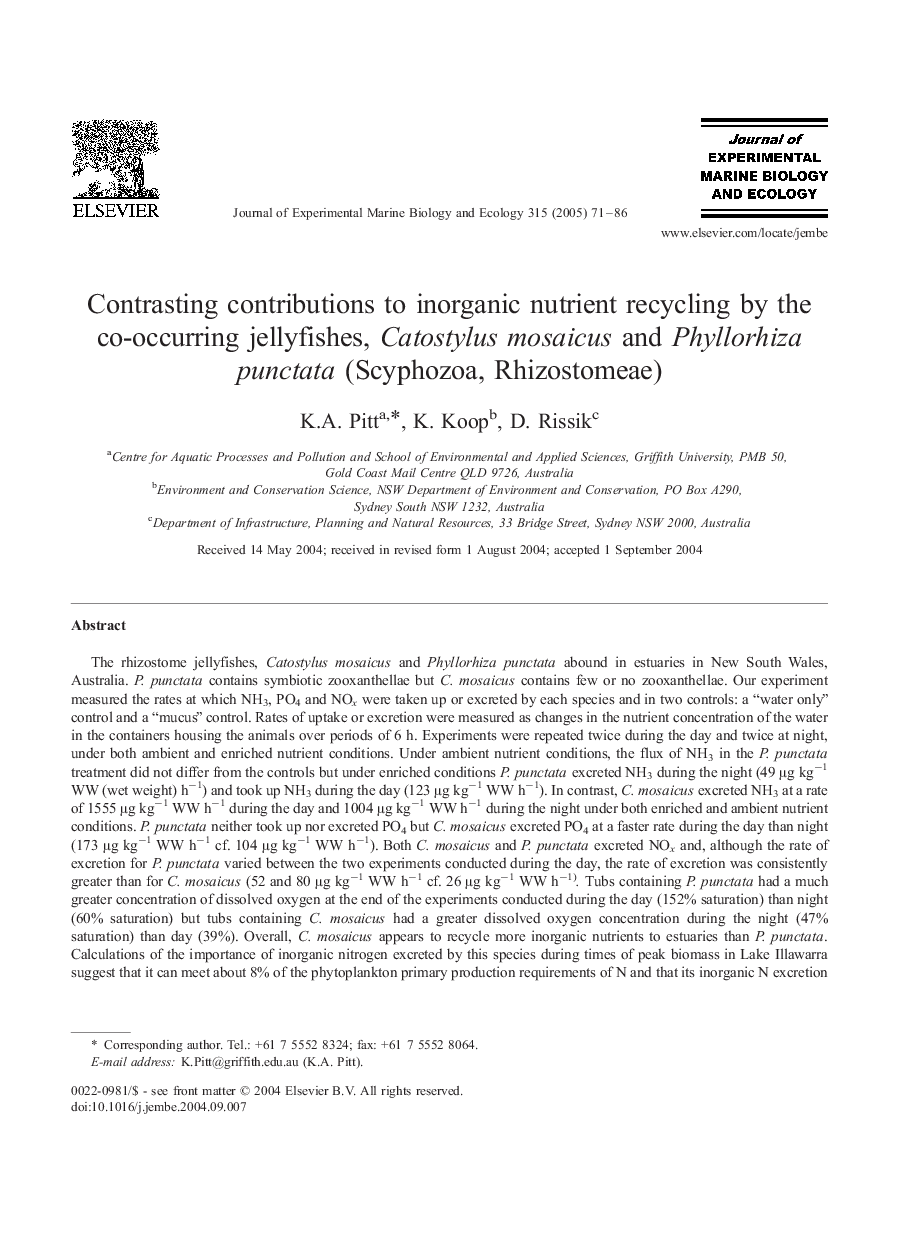| کد مقاله | کد نشریه | سال انتشار | مقاله انگلیسی | نسخه تمام متن |
|---|---|---|---|---|
| 9448819 | 1305957 | 2005 | 16 صفحه PDF | دانلود رایگان |
عنوان انگلیسی مقاله ISI
Contrasting contributions to inorganic nutrient recycling by the co-occurring jellyfishes, Catostylus mosaicus and Phyllorhiza punctata (Scyphozoa, Rhizostomeae)
دانلود مقاله + سفارش ترجمه
دانلود مقاله ISI انگلیسی
رایگان برای ایرانیان
موضوعات مرتبط
علوم زیستی و بیوفناوری
علوم کشاورزی و بیولوژیک
علوم آبزیان
پیش نمایش صفحه اول مقاله

چکیده انگلیسی
The rhizostome jellyfishes, Catostylus mosaicus and Phyllorhiza punctata abound in estuaries in New South Wales, Australia. P. punctata contains symbiotic zooxanthellae but C. mosaicus contains few or no zooxanthellae. Our experiment measured the rates at which NH3, PO4 and NOx were taken up or excreted by each species and in two controls: a “water only” control and a “mucus” control. Rates of uptake or excretion were measured as changes in the nutrient concentration of the water in the containers housing the animals over periods of 6 h. Experiments were repeated twice during the day and twice at night, under both ambient and enriched nutrient conditions. Under ambient nutrient conditions, the flux of NH3 in the P. punctata treatment did not differ from the controls but under enriched conditions P. punctata excreted NH3 during the night (49 μg kgâ1 WW (wet weight) hâ1) and took up NH3 during the day (123 μg kgâ1 WW hâ1). In contrast, C. mosaicus excreted NH3 at a rate of 1555 μg kgâ1 WW hâ1 during the day and 1004 μg kgâ1 WW hâ1 during the night under both enriched and ambient nutrient conditions. P. punctata neither took up nor excreted PO4 but C. mosaicus excreted PO4 at a faster rate during the day than night (173 μg kgâ1 WW hâ1 cf. 104 μg kgâ1 WW hâ1). Both C. mosaicus and P. punctata excreted NOx and, although the rate of excretion for P. punctata varied between the two experiments conducted during the day, the rate of excretion was consistently greater than for C. mosaicus (52 and 80 μg kgâ1 WW hâ1 cf. 26 μg kgâ1 WW hâ1). Tubs containing P. punctata had a much greater concentration of dissolved oxygen at the end of the experiments conducted during the day (152% saturation) than night (60% saturation) but tubs containing C. mosaicus had a greater dissolved oxygen concentration during the night (47% saturation) than day (39%). Overall, C. mosaicus appears to recycle more inorganic nutrients to estuaries than P. punctata. Calculations of the importance of inorganic nitrogen excreted by this species during times of peak biomass in Lake Illawarra suggest that it can meet about 8% of the phytoplankton primary production requirements of N and that its inorganic N excretion rate is about 11% of measured inorganic ammonia fluxes from sediments in that system. Since the biomass of C. mosaicus often exceeds several thousand tonnes, the contribution of inorganic nutrients by this species is substantial.
ناشر
Database: Elsevier - ScienceDirect (ساینس دایرکت)
Journal: Journal of Experimental Marine Biology and Ecology - Volume 315, Issue 1, 15 February 2005, Pages 71-86
Journal: Journal of Experimental Marine Biology and Ecology - Volume 315, Issue 1, 15 February 2005, Pages 71-86
نویسندگان
K.A. Pitt, K. Koop, D. Rissik,